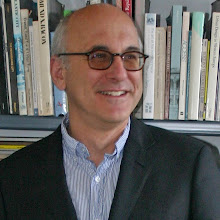Mayors discussing urbanism on 11/15/10 at the Villa Galilee in Zefat, Israel.
Today I was not so much a traveler as a listener (and sometimes contributor). For close to twelve hours I was immersed in the first of two days of discussions regarding development, redevelopment, urban design, planning, financing, branding, transit and traffic planning, affordable housing, and the politics of city design - in Israel. While I was asked my opinion of the four city schemes we were presented, my opportunity was to listen and learn about how a very different urban environmental design culture works, or in some cases does not.
Here are ten unformed observations in no particular order or hierarchy.
- There is a 100% tariff on new cars imported into Israel. Not surprisingly there are at present one-third the cars per capita as there are in the United States, yet I am told that government policies push development out to the periphery of the country where there is poor transit service; thus encouraging more car ownership and the consequences of ever more sprawl.
- Countering the prospects for future sprawl, Israel is building both trains and light-rail systems. Bus rapid transit is also being adopted. I observed and heard about bus-only lanes in the middle of roads and through the center of cities respectively. Jitneys are also a popular form of transit. I saw, while stuck in a traffic jam, police stop a 10-person jitney for utilizing an empty bus-only lane. I guess jitneys are not yet recognized as mass transit. Policies that relate urban form to transit are chaotic, with simultaneous expansion of all system types, including the single-occupant vehicle, and little rigor with regard to the niceties of transit-oriented development or the location of station stops. Still, with all this transit construction, the country is aggressively anticipating the realization of a "multi-modal" future.
- Israel fosters for better and for worse "towers in a park" suburbanism. I saw several examples of new project proposals replete with towers, unprogarmmed green swaths, cul-de-sacs, and island-like urban definition where nothing was connected to nothing.
- There is no tax increment financing, local redevelopment agencies, complex financial tools, or even a great deal of awareness of the complex real estate mechanisms that are at the root of American development practices. On the other hand, the mortgage market did not collapse here and there are cranes and development expectations everywhere.
- Housing in Tel Aviv is phenomenally expensive. But, outside of a couple of pockets scattered elsewhere, housing is often cheap, encouraging further disbursement of urbanism into a diminishing countryside. "Affordable" housing as practiced in the United States, with all of its its incentives, subsidies, financing mechanisms, and types, is little known here.
- People get nervous as opposed to excited about the art of the deal as practiced by captains of American real estate development like Donald Trump. Deals quickly become moral dilemmas as much as development dilemmas. Maybe that is a good thing.
- Sustainability is not quite the impulse, fad, or framework that is familiar to those that design and develop in California. However, its coming. Israel will probably wean itself from foreign oil long before the United States. On a small scale, I saw Platanus Racemosa (California Sycamore) street trees being utilized because of their drought resistance (and lovely deciduous canopy), flipping on its head for me the notion of the definition of Mediterranean landscape.
- There are fewer checks and balances to the development process as much of it is top down, from the central government to the local jurisdiction, with little or cursory input and participation into decision-making. On the other hand, centralized planning is a good thing when you think it is good for you (and a bad thing when you are convinced it is not).
- The design of Israel, if you will, is still influenced by the legacy of the socialist founders and governments, left and right, that shape urban and development policy to this day. Another way of saying it is that they are designing their country and are even at times critical of its design. I am not sure anybody is as actively designing or at the top levels actively criticizing the design of the United States.
- Religious people, religious neighborhoods, and design for minorities are delicately spoken factors influencing the shaping of urban growth as well as urban form expectations. In some ways this is akin to working with equivalent communities in the United States, but there is much less confidence that outcomes can be salutary.



